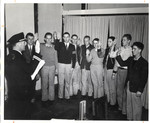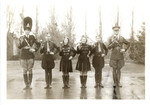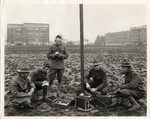
Military review of cadets by then Governor Sprague, possible date, May 1941. Military parade of cadets marching in formation past reviewing stand with dignitaries. Weatherford Hall in background of parade field has scaffolding on center tower as seen in other photographs of this vintage.
With the expansion of the Army to unprecedented size for the Civil War, the need for trained officers quickly exceeded the number available. As a result, Congress passed the Land Grant Act of 1862 which specified that courses in military tactics should be offered at colleges established as a result of the Act.
Corvallis College (now Oregon State University) was founded in 1858 as an Academy supported by the Methodist Church. In 1868 it was named a Land Grant Institution, and by 1872 the first Cadet Corps was formed under the command of Captain Benjamin D. Boswell, an active duty officer on extended leave in Corvallis. In 1911, McAlexander Fieldhouse, one of the oldest buildings on campus, was dedicated to Major Ulysses G. McAlexander, then the Professor of Military Science and Tactics, who went on to become known as "The Rock of the Marne" as commander of the 38th Infantry, 3rd Infantry Division during World War I.
The National Defense Act of 1916 expanded and standardized the training of officers, colleges and universities and established the Reserve Officer Training Corps (ROTC) in essentially the same form as it is known today. This program replaced other military training at OSU in 1917 and continued virtually unchanged until 1962 when ROTC became voluntary.
Historically, all physically qualified male OSU students were required to take the first two years of ROTC instruction. The program took a significant step forward in 1973 when women were allowed to enroll.
Today, OSU Army ROTC continues the tradition of "The West Point of the West,” the nickname earned during World War II when the OSU Corps produced more officers than any other non-military academy in the nation. Our Army ROTC graduates continue their proud heritage of dedicated service to the nation, while our current cadets accept the challenges of the ROTC program as they prepare to be tomorrow’s leaders.

OAC Cadets perform exhibition battle scene on the athletic field, during the Military Tournament 1927. The photo originally appeared in the 1927 Beaver Yearbook, page 267 under the title "Sham Battle". Of note is the use of WWI surplus equipment, this includes the style of helmet and gas masks as well.

Machine Gun training post WWI beside Armory, c. 1920. Cadets are seen training with the Browning M1917A1 .303 Water Cooled machine gun. This photo, probably just after WWI shows training cadets in setting up and firing the gun.

US Navy officer swearing in new recruits, 1942. The Navy V-12 and Army ASTP programs were located on OSC campus during WWII. This photo originally appeared on pg. 235 of the 1943 OSC Beaver Yearbook.

Military encampment on campus adjacent to Weatherford Hall, ca. 1936. Period vehicles including trucks and sedans. Tents of different configurations from 2 man "pup tents" to larger personnel tents. Photograph was originally published image in Beaver Yearbook, 1936.

Cadet band drum majors and majorettes in full dress uniforms, c. 1935. The 2 ROTC drum majors on each end of group are wearing the standard mid 30s dress coat with service breeches (jodhpurs pants). Sam Brown belts with high leather boots. The 4 "junior" drum majors and majorettes are wearing non standard uniforms, probably band issued with garrison caps.

Caption on reverse is typed on a small tag, stating "President Kerr addressing (sic) the S.A.T.C. (Student Army Training Corps) at the Inaugural Exercises, Oct. 1, 1918". The first four rows of crowd are cadets, with civilian onlookers in rear.


